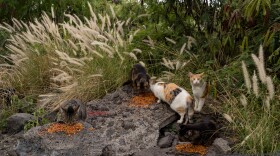Hawaiʻi Volcanoes National Park on the Big Island was given new land on Tuesday in a deal that will protect and manage a pristine white sand beach and ocean bay area that is home to endangered and endemic species and to rare, culturally significant Native Hawaiian artifacts.
Trust for Public Land, a national nonprofit land preservation group, transferred its ownership of Pōhue Bay and surrounding land to the National Park Service.
Hawaiʻi Volcanoes National Park has the world's largest and most active volcanoes, Mauna Loa and Kilauea. Most of the coastline where the bay is located is made of ancient lava flows, black rock and sea cliffs that dart out into the ocean.
Pōhue Bay, a rare and idyllic oasis in an otherwise rugged landscape, is home to endangered hawksbill sea turtles, green sea turtles, endangered Hawaiian monk seals and other species found only in Hawaiʻi. The area houses anchialine ponds — landlocked pools with a mix of fresh and salt water — where rare Hawaiian red shrimp called ʻōpaeʻula live.

The area is also culturally significant because it has remains of ancient Hawaiian villages, petroglyphs, burial sites and the largest known abrader tool quarry in the state, according to the Trust for Public Land. Abraders are ancient tools used for sanding, smoothing and grinding.
Park officials hope to eventually open the area up to the public, but the 26 square miles (67 square kilometers) of land will remain closed to visitors as national park staff consult with local experts and residents to better understand the various cultural sites.
Access to Pōhue Bay will be difficult because the trails and roads that lead to the bay are still under private ownership. NPS has no plans to acquire the neighboring lands at this time.
The addition brings the total park size to 554 square miles (1,425 square kilometers), almost as large as the entire island of Oʻahu.
While the park has recently acquired a few small parcels of land in the same area, the donation is the park's largest addition since 2003, when about 156 square miles (404 square kilometers) of land was incorporated.

Hawaiʻi Volcanoes National Park Superintendent Rhonda Loh said the acquisition allows the NPS tp preserve the resources in the long term.
"It was private ownership. It's really up to the owner how they envision managing the land and it can vary," Loh told HPR. "You may have someone who's more preservation or conservation-minded, or someone who's more on the other end and looking at more development and commercial purposes. And if the owner sells the land, that purpose can change."
Trust for Public Land acquired the privately owned land on Tuesday and gave it to Hawaiʻi Volcanoes National Park the same day.
The parcel stretching from the southwest coast of Hawaiʻi Island up to the national park was purchased for $9.4 million with funding from the Land and Water Conservation Fund and a donation from the Wyss Foundation. The land had previously been the target of several resort proposals, Trust for Public Land said.
“We are grateful the National Park Service will steward the area, ensuring the history, culture and natural beauty of this place are protected for future generations," Trust for Public Land Associate Vice President Lea Hong, who leads the Hawaiʻi division for the organization, said in a statement.
Hong emphasized the role locals have played in preserving the land, fighting off pressure from developers and others to keep the area natural.
“It’s really a testament to decades of community concern and love for that area," Hong said. “It’s a testament to the community’s dedication to conserving the coastline that this project will happen.”





